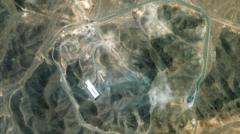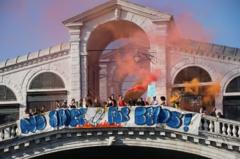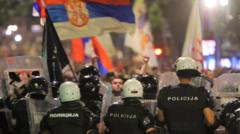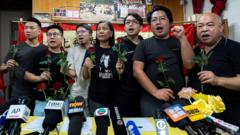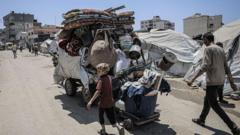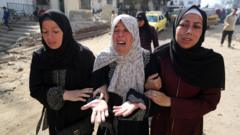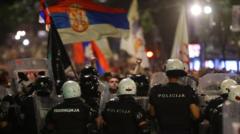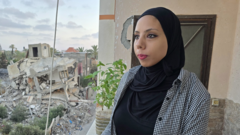In the aftermath of conflict, the spirit of the people remains intact, highlighting a complex narrative of hope, despair, and resilience in Iran's capital.
**Tehran's Resilience Amidst Turmoil: A City Struggles for Recovery**
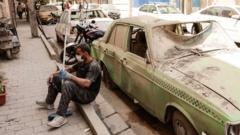
**Tehran's Resilience Amidst Turmoil: A City Struggles for Recovery**
Tehran begins to recover from a recent wave of violence, yet its citizens grapple with uncertainty and fear for the future.
In the heart of Tehran, life slowly resumes, yet the haunting echoes of recent turmoil linger in the air. The Boof cafe, located at a historically significant site—the now-closed US embassy—serves refreshing iced drinks amidst high cement walls adorned with anti-American murals. Barista Amir expresses a shared longing for improved relations with the US, lamenting the economic toll of sanctions on local businesses.
As the cafe patrons—a blend of traditional and modern attire—reflect the diverse fabric of Iranian society, a stark contrast plays out just a short drive away at the IRIB state TV station. The broadcast of Supreme Leader Ayatollah Ali Khamenei conveys a defensive rhetoric toward the US, asserting that opposition to Iran's regime is a consistent battle. This address comes after significant Israeli strikes targeting military infrastructure and personnel.
At the IRIB complex, the remnants of destruction serve as a grim reminder of the ongoing conflict. The main studio, once a hub for national news, now lies in ruins, its contents reduced to smoldering debris. Nearby, hospitals are filled with casualties from the violence, including Ashraf Barghi, a head nurse at Taleghani General Hospital, who treats a chilling number of severely wounded patients.
The Iranian government's health ministry estimates at least 627 fatalities and thousands injured in the recent turmoil, illustrating the high human cost of conflict. However, Tehran citizens begin to navigate back to their normalcy, shops are reopening, and traffic flows back onto the streets. Nonetheless, the emotional scars remain, as Mina, a local woman, expresses despair over the uncertain future.
Amidst this intricate tapestry of recovery, a performance by the Tehran Symphony Orchestra aims to bring solace to a weary populace gathered at the Azadi Tower. Opinions regarding the government's approach to the crisis surface, with citizens calling for greater freedoms and more acknowledgment of their voices.
As Iran faces an ambiguous political landscape, residents are left balancing resilience with anxiety, eagerly awaiting shifts that could redefine their lives. In a nation steeped in historical conflict, the resilience of its people continues to shine, albeit under a looming cloud of uncertainty regarding their future.
Reporting requires strict adherence to governmental regulations, limiting the disclosure of specific insights, yet the voice of Iran's populace grows ever clearer in their pursuit of peace and stability.
As the cafe patrons—a blend of traditional and modern attire—reflect the diverse fabric of Iranian society, a stark contrast plays out just a short drive away at the IRIB state TV station. The broadcast of Supreme Leader Ayatollah Ali Khamenei conveys a defensive rhetoric toward the US, asserting that opposition to Iran's regime is a consistent battle. This address comes after significant Israeli strikes targeting military infrastructure and personnel.
At the IRIB complex, the remnants of destruction serve as a grim reminder of the ongoing conflict. The main studio, once a hub for national news, now lies in ruins, its contents reduced to smoldering debris. Nearby, hospitals are filled with casualties from the violence, including Ashraf Barghi, a head nurse at Taleghani General Hospital, who treats a chilling number of severely wounded patients.
The Iranian government's health ministry estimates at least 627 fatalities and thousands injured in the recent turmoil, illustrating the high human cost of conflict. However, Tehran citizens begin to navigate back to their normalcy, shops are reopening, and traffic flows back onto the streets. Nonetheless, the emotional scars remain, as Mina, a local woman, expresses despair over the uncertain future.
Amidst this intricate tapestry of recovery, a performance by the Tehran Symphony Orchestra aims to bring solace to a weary populace gathered at the Azadi Tower. Opinions regarding the government's approach to the crisis surface, with citizens calling for greater freedoms and more acknowledgment of their voices.
As Iran faces an ambiguous political landscape, residents are left balancing resilience with anxiety, eagerly awaiting shifts that could redefine their lives. In a nation steeped in historical conflict, the resilience of its people continues to shine, albeit under a looming cloud of uncertainty regarding their future.
Reporting requires strict adherence to governmental regulations, limiting the disclosure of specific insights, yet the voice of Iran's populace grows ever clearer in their pursuit of peace and stability.

